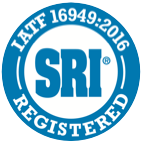Powder Metal Parts Manufacturer - Sintered Metal Parts
Atlas Pressed Metals, a leading sintered and powdered metal parts manufacturer, partners with our customers to supply all volume powdered metal parts for a wide range of applications, including:
We thrive on providing our customers with cost-effective powder metal manufacturing solutions. With our engineering and metallurgical capabilities, advanced manufacturing and quality processes, in-house secondary machining, and tool and die facility, we collaborate with our customers to design components that meet and exceed application requirements.
Types of Powdered Metal Parts Manufactured by Atlas Pressed Metals
Powdered Metal Parts
Structural Components
Atlas’s state-of-the-art metallurgical and engineering capabilities, combined with our wide variety of presses, sintering furnaces, and in-house secondary operations, offer our structural component customers the opportunity for high-quality components, reduced turnaround, and cost savings. Click to learn more.
Powdered Metal Parts
Gears
Our state-of-the-art automation and material handling systems and our in-house expert metallurgists allow Atlas to produce multilevel gears with internal configurations to tight tolerances to eliminate or reduce the need for additional operations. Click to learn more.
Powdered Metal Parts
Bearings
Custom metal bearings and bushings benefit from powder metal manufacturing due to the ability to impregnate the part with lubrication, extending run-time and minimizing maintenance. Click to learn more.

Materials Used for Manufacturing Powdered Metal Parts
Powder metallurgy process begins with a collection of metal powder particles.
Metal powders are engineered materials that meet a wide range of performance requirements. Understanding the powder is crucial in powder metallurgy as this is the key input to the production of a final metal component.
Metal powders are classified as elemental, partially-alloyed, or pre-alloyed. Elemental powder is a granular form of pure metal powder. They are the building blocks of creating alloys and composite materials. Partially-alloyed powders are a mixture of elemental powders of different materials blended together, and a pre-alloyed material is in an alloyed state as produced by atomizing a combination of metals.
In most cases, the powder mixture, whether elemental or pre-alloyed, also contains additives (lubricants or binders) for increased tool life, to assist in the ejection of the component from the compaction die or to hold the metal part together before the sintering process. These additives are removed from the component during the sintering process.
Powders used:
- Iron
- Carbon steel
- Nickel steel
- Copper steel
- Stainless steel
- Low-alloy steel
- Sinter Hardened steel
- Diffusion steel
- Infiltrated steel
- Electromagnetic Materials
- Brass
- Bronze
- Copper
- Aluminum
Benefits of Manufacturing Powder Metal/Sintered Parts
Utilizing powder metallurgy for part manufacturing provides many benefits, including tight tolerances, quiet operation, and the capacity for higher volumes. A key benefit of using powdered metal is cost-efficiency. Manufacturing sintered metal parts allows Atlas to meet tight tolerances and, for many applications, reduce the need for additional finishing operations.
With little to no waste, powdered metal is a green process due to its low energy usage and minimal scrap, making it more economical than standard machining or casting. Material selection for powdered metal parts allows for optimizing metal part’s performance for its intended application with little variation in the manufacturing process.
At Atlas Pressed Metals, we specialize in this dynamic process; our team has a deep understanding of more than just powdered metal part and sintered parts manufacturing. Our team also provides a high level of expertise in engineering and the material science surrounding powder metallurgy. This means that we can recommend metal powders and powder blends that help our customers design parts that will optimize performance. When a properly selected material is combined with appropriate process parameters, the result is a metal part that meets the application requirements with proven cost-savings over conventional machining methods. This method is ideally suited for the manufacturing of metal parts in high volume applications because geometries formed by the die show little to no variation.
Atlas Pressed Metals Specializes in Precision Sintered Parts
Our production facility is equipped with a wide range of state-of-the-art systems that utilize automation and specialty designed handling systems that add an even greater level of efficiency to this highly efficient process. For our powdered metal parts, we provide extensive finishing capabilities, including:
- Machining
- Sizing
- Plating
- Heat Treating
- Impregnation and Lubricants
- Standard and Special Coatings
- And More!
Our New Product Development process is managed by a team of Atlas Pressed Metal engineers who will work with our customers during the design phase by providing application knowledge and assistance in material selection to optimize the cost-effectiveness and manufacturability of the powdered metal part. With Atlas Pressed Metals’ diverse customer base, our experience in manufacturing precision PM parts with unique configurations and challenging complexity is well-established.
Custom Powder Metal Parts Specifications
For structural, spherical, or flanged sintered parts up to, but not limited to, 6800 grams (15 lbs.) in weight, with dimensions of 3mm (0.125”) to 250mm (10”) in diameter and 3mm (0.125”) to 76mm (3”) in length, powdered metal is the ideal “cost out” solution.
Conversion of Machined Parts to Powdered Metal Parts
The decision to use a specific metal forming technology is dependent on part complexity, specific mechanical requirements and application, production volume and part life, and cost consideration.
Advantages of Powder Metallurgy are very clear when the desired component requires:
- A unique or complex shape that would be impossible, costly, or impracticable to manufacture using other metal forming technologies.
- Part-to-part reproducibility and repeatability with tight dimensional requirements over moderate to high volume applications.
- Long-term reliability in critical applications.
- Controlled porosity for self-lubrication
- Unique requirements that may be solved with the appropriate material selection and processing strategies.
- Specific strength, wear resistance, and surface finish requirements.
- Cost competitive through reduced material losses and eliminating or minimizing secondary operations such as machining.
Understanding Powder Metallurgy
Step One: Collaborative review of your new part design or an evaluation of a potential conversion to powder metal for an existing part
Step Two: Selecting the best powder or powder blend for durability, reliability, and accuracy
Step Three: Compacting the metal powder to precise specifications under controlled pressure
Step Four: Heating or "Sintering" to create a permanent form
To learn more about powdered metal manufacturing, gear requirements and how the powder metal process can reduce the cost of your next gear project, please contact us.
contact information
Mailing Address
125 Tom Mix Dr.
P.O. Box P
DuBois, PA 15801
USA
Fax(814) 371-4182
testimonials
“Atlas Pressed Metals is a professional organization with great knowledge, experience and expertise in the PM industry. They have a clean, well run, world class facility, operated by a very talented and experienced staff. It is a pleasure to work with them.”
.png)



